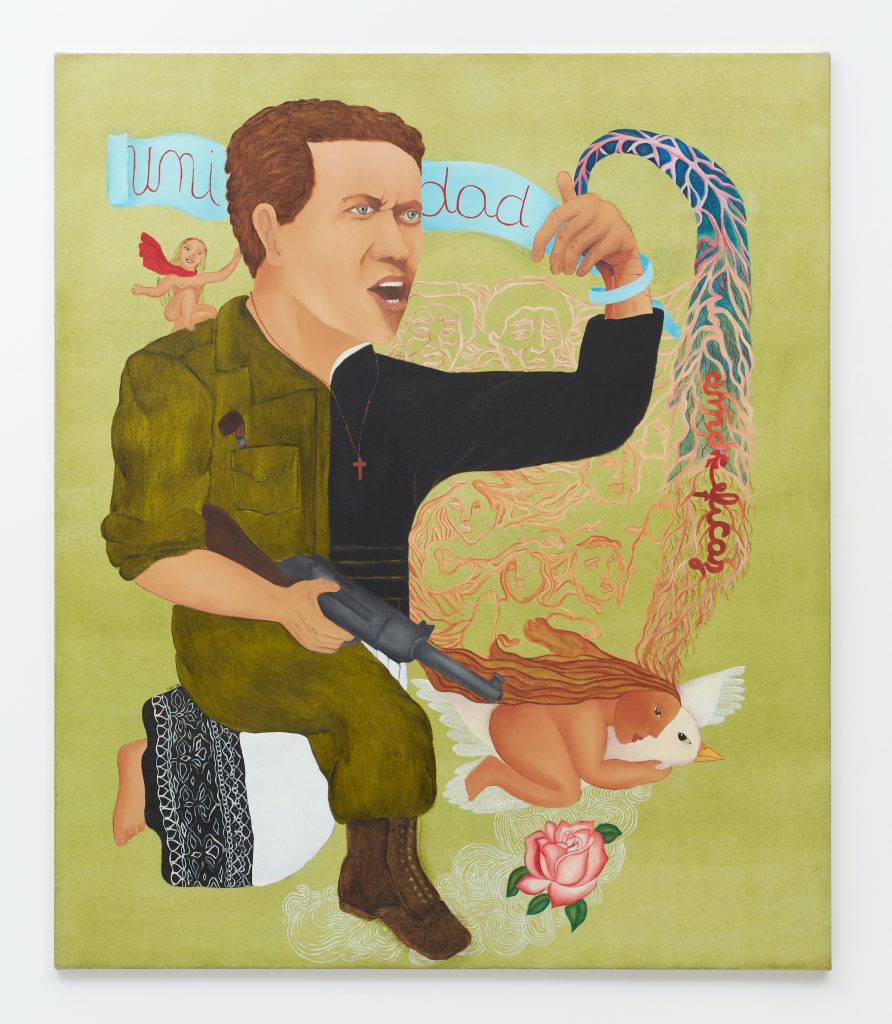
Cecilia Vicuña, Camillo Torres, 1978, oil on cotton canvas, 139,4 x 118,7 cm, courtesy the artist and Lehmann Maupin, New York / Hong Kong / Seoul, photo: Matthew Herrmann
Cecilia Vicuña, Camillo Torres, 1978, oil on cotton canvas, 139,4 x 118,7 cm, courtesy the artist and Lehmann Maupin, New York / Hong Kong / Seoul, photo: Matthew Herrmann

“I heard her as a distant relative coming home to nothingness.”
—Cecilia Vicuña
Cecilia Vicuña introduces us to Theresa Hak Kyung Cha’s literary tour de force Dictée (1982) in her installation Rain Dreamed by Sound (2020), composed in collaboration with musician Ricardo Gallo, laying emphasis on the work of mourning, poetry’s commemorative function, and the way women-centered language might reverberate and overpower the enduring nightmares of gender violence. As two artist-poets who migrated to New York from Chile and Korea, respectively, Vicuña and Hak Kyung Cha have manifested poetry and improvisational performance as connective signs from feminist, shamanic, and matriarchal traditions. Though a meeting between the two never materialized, Vicuña encircles Hak Kyung Cha in her sonic encounter as a “distant relative” and muse, a relatedness as unstoppable as rain. Whispered longings for a return from trauma and broken silence eventually carry forth from piano notes and breath chants to a shared pause in the waiting grounds where language is reparation.
Lucy Lippard describes Vicuña as “an archaeologist of language—excavating, dissecting, recreating meaning and communicating it to the inhabitants of today.” She closely regards the passage of memory across generations and the preservation of indigenous practices. On the interwoven quality of text and textile across her work, Vicuña prompts, “Do threads speak in knots?” For decades she has created quipus, mnemonic devices and offerings to the seas, mountain cliffs, and forests, that are assembled as spontaneous monuments in the streets and, more recently, in museum spaces. These constellations of unprocessed wool, stones, and debris symbolize the womb, indigenous ties, and planetary cycles, foregrounding sensorial knowledge from Andean philosophy and pre-Columbian cultures stretching from Colombia to Chile. In exile in London and Colombia since the early 1970s, a response to the military coup against elected president Salvador Allende, Vicuña made several paintings, including El Paro (The Strike) and Homenaje a Vietnam (Homage to Vietnam) (both 1977), that were later lost. She has recently revisited these works to make what she considers as “doubles,” recomposing them from memory and old contact sheets. Artistic processes have served as vehicles for ritual and solidarity-building since the artist responded to the My Lai massacre during the Vietnam War with a performance in Santiago, and continues to demonstrate the feminist alliance building that unfolds to this day through the revolution in Chile.
Cecilia Vicuña, My Vietnam Story, 2021
Video, sound
6:45
Camera and editing Fran Benitez
Cecilia Vicuña, Camillo Torres, 1978, oil on cotton canvas, 139,4 x 118,7 cm, courtesy the artist and Lehmann Maupin, New York / Hong Kong / Seoul, photo: Matthew Herrmann